| Carangidae (Jacks and pompanos), subfamily: Caranginae |
| 117 cm FL (male/unsexed); max.weight: 44 kg |
|
reef-associated; brackish; marine; depth range 0 - 190 m |
| Indo-Pacific: Red Sea and East Africa to Ducie Island, north to the Ryukyu Islands, south to New Caledonia. Eastern Central Pacific: Mexico to Panama (Ref. 9283). Hybrid with Caranx sexfasciatus found in Hawaii (Ref. 58422). |
|
Dorsal spines (total): 9-9; Dorsal soft rays (total): 21-24; Anal spines: 3-3; Anal soft rays: 17-21; Vertebrae: 24-24. This species is distinguished by the following characters: gill rakers (including rudiments) 5-9 + 17-21 = 25-29 (usually 26-27); breast completely scaly; straight part of lateral line with 0-10 anterior scales followed by 27-42 strong scutes; adipose eyelid weakly developed, small anteriorly, posterior adipose eyelid extends onto eye to rear border of pupil in large adults; upper jaw with outer row of strong canines widely spaced in adults, and an inner band of small villiform teeth, widest at symphysis; lower limb of first gill arch jaw with a single row of strong
conical teeth widely spaced in adults. Colour of adults with head and dorsal half of body brassy, suffused with blue, and covered with small blue black spots (forming at about 16 to 22 cm fork length and increasing in number with size); second dorsal, anal, and caudal fins electric blue; juveniles and young adults, head and body silvery grey and fins pale to dark dusky, except pectoral fins yellow (Ref. 9894, 90102).
Description: Body oblong and compressed, dorsal profile moderately convex to second dorsal fin, ventral profile slightly convex (Ref. 90102). Pectoral fins falcate (Ref. 2334). |
| The most common trevally in coral reefs occurring singly or occasionally in schools (Ref. 90102). Adults are pelagic in coastal and oceanic waters, associated with reefs (Ref. 9283, 58302). Juveniles occur seasonally in shallow sandy inshore waters (Ref. 9710) and rivers (Ref. 12792). Adults feed mainly on other fishes (Ref. 9283) and crustaceans (Ref. 9710). They are often toxic when length reaches more than 50 cm (Ref. 4795). Mainly marketed fresh, but also dried or salted (Ref. 9283). They are caught primarily on hook-and-line and by spearing; also with traps and gill nets. An excellent sports fish (Ref. 9894). |
|
Least Concern (LC); Date assessed: 09 March 2015 Ref. (130435)
|
| reports of ciguatera poisoning |
|
Source and more info: www.fishbase.org. For personal, classroom, and other internal use only. Not for publication.

